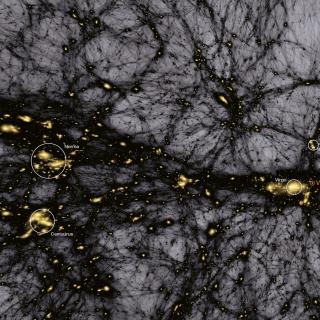Bibcode
Blot, L.; Crocce, Martin; Sefusatti, Emiliano; Lippich, Martha; Sánchez, Ariel G.; Colavincenzo, Manuel; Monaco, Pierluigi; Alvarez, Marcelo A.; Agrawal, Aniket; Avila, Santiago; Balaguera-Antolínez, A.; Bond, Richard; Codis, Sandrine; Dalla Vecchia, C.; Dorta, A.; Fosalba, Pablo; Izard, Albert; Kitaura, F.-Sh.; Pellejero-Ibanez, M.; Stein, George; Vakili, Mohammadjavad; Yepes, Gustavo
Bibliographical reference
Monthly Notices of the Royal Astronomical Society, Volume 485, Issue 2, p.2806-2824
Advertised on:
5
2019
Citations
84
Refereed citations
77
Description
We study the accuracy of several approximate methods for gravitational
dynamics in terms of halo power spectrum multipoles and their estimated
covariance matrix. We propagate the differences in covariances into
parameter constraints related to growth rate of structure,
Alcock-Paczynski distortions, and biasing. We consider seven methods in
three broad categories: algorithms that solve for halo density evolution
deterministically using Lagrangian trajectories (ICE-COLA, PINOCCHIO,
and PEAKPATCH), methods that rely on halo assignment schemes on to dark
matter overdensities calibrated with a target N-body run (HALOGEN,
PATCHY), and two standard assumptions about the full density probability
distribution function (Gaussian and lognormal). We benchmark their
performance against a set of three hundred N-body simulations, running
similar sets of approximate simulations with matched initial conditions,
for each method. We find that most methods reproduce the monopole to
within 5{{ per cent}}, while residuals for the quadrupole are sometimes
larger and scale dependent. The variance of the multipoles is typically
reproduced within 10{{ per cent}}. Overall, we find that covariances
built from approximate simulations yield errors on model parameters
within 10{{ per cent}} of those from the N-body-based covariance.
Related projects

Numerical Astrophysics: Galaxy Formation and Evolution
How galaxies formed and evolved through cosmic time is one of the key questions of modern astronomy and astrophysics. Cosmological time- and length-scales are so large that the evolution of individual galaxies cannot be directly observed. Only through numerical simulations can one follow the emergence of cosmic structures within the current
Claudio
Dalla Vecchia

Cosmology with Large Scale Structure Probes
The Cosmic Microwave Background (CMB) contains the statistical information about the early seeds of the structure formation in our Universe. Its natural counterpart in the local universe is the distribution of galaxies that arises as a result of gravitational growth of those primordial and small density fluctuations. The characterization of the
FRANCISCO SHU
KITAURA JOYANES